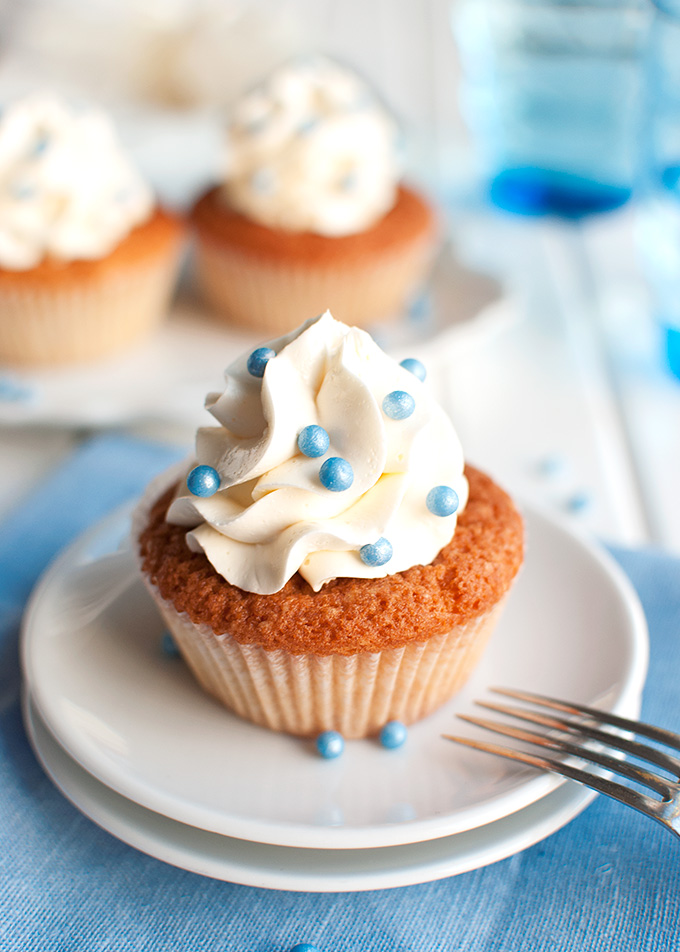 Ready, set, drum roll please…. Finally, after weeks of anxious anticipation it is here as promised: my new and improved recipe for Swiss Buttercream. Yay!
Ready, set, drum roll please…. Finally, after weeks of anxious anticipation it is here as promised: my new and improved recipe for Swiss Buttercream. Yay!
Okay, so the final installment of my Battle of the Buttercreams 2.0 series almost took forever to post. But I’m officially still on maternity leave, so I guess I actually delivered this recipe to you a bit early…? Just joking. Speaking of maternity leave, mine’s almost over. And Baby Boy is getting so big! He’s just learned to grasp things. <– proud momma moment! 😀
But let’s not digress too much. Just a little more. To remind everyone why I’m posting this again. I guess we can all use a little reminder right about now…
So. This is the thirteenth post of my Battle of the Buttercreams 2.0 series. As trusty readers know, I already posted about American buttercream, Flour (or Ermine) buttercream, French buttercream, German buttercream, and Italian buttercream. I also posted recipes for several delicious buttercream variations, including pumpkin spice, chocolate and caramel buttercream. As far as I know, there are six different kinds of buttercream, which makes Swiss buttercream (also known as Swiss meringue buttercream) the last type of buttercream I’ll be discussing in this series.
Swiss buttercream is a delicious buttercream with a pleasantly light flavor and a velvety texture, which is made by beating cubes of softened butter into a Swiss meringue. Hence the alternative name ‘Swiss meringue buttercream’. Obvs…
Anyway, if you’re not sure about how to make a Swiss meringue, hop on over to this post before reading on!
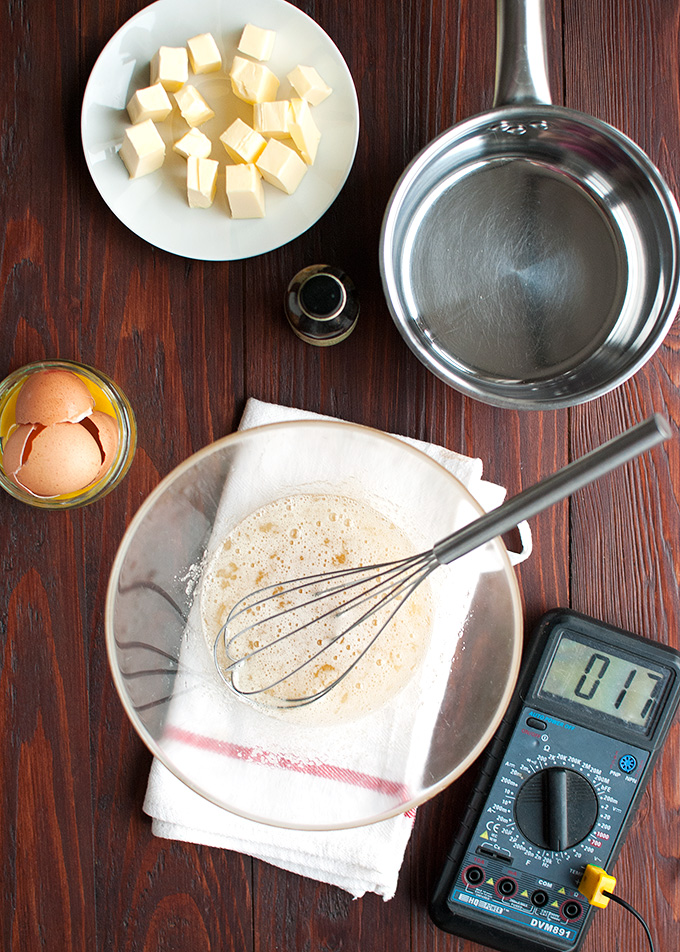 Because Swiss buttercream is made by mixing butter into meringue, it’s very similar to Italian buttercream. In fact, the only difference lies in the preparation method of the meringue. While Swiss meringue is made by gently heating egg whites and sugar in a double boiler, Italian meringue is made by mixing hot sugar syrup into egg whites. The Swiss method allows you to pasteurize the egg whites by bringing the whites up to a temperature of 71°C/160°F, while the Italian method does not actually pasteurize the whites. In other words, when it comes to meringue-based buttercreams, the Swiss one is the salmonella-safe option!
Because Swiss buttercream is made by mixing butter into meringue, it’s very similar to Italian buttercream. In fact, the only difference lies in the preparation method of the meringue. While Swiss meringue is made by gently heating egg whites and sugar in a double boiler, Italian meringue is made by mixing hot sugar syrup into egg whites. The Swiss method allows you to pasteurize the egg whites by bringing the whites up to a temperature of 71°C/160°F, while the Italian method does not actually pasteurize the whites. In other words, when it comes to meringue-based buttercreams, the Swiss one is the salmonella-safe option!
In general, I don’t worry about salmonella too much when using raw eggs, but it’s definitely something to keep in mind when baking for a party. I know pregnant women aren’t too keen on raw eggs, for example… 😉
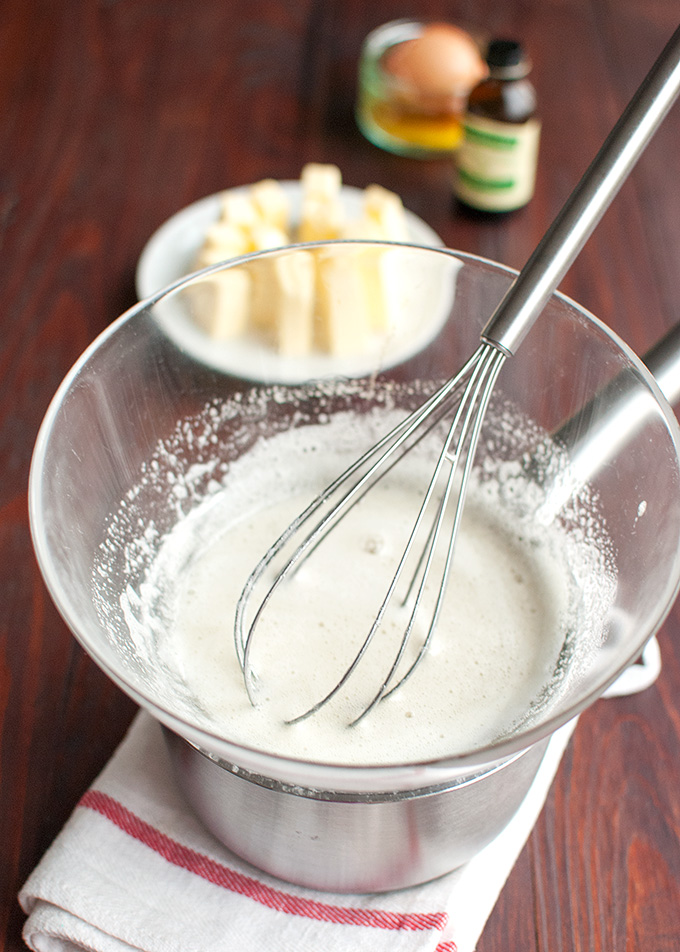 But anyway, what do you need to make Swiss buttercream? I’ll tell you: everything you need to make Swiss meringue, AND unsalted butter. Which means: egg whites, sugar, and butter. And maybe a bit of vanilla, if you’re making vanilla Swiss buttercream.
But anyway, what do you need to make Swiss buttercream? I’ll tell you: everything you need to make Swiss meringue, AND unsalted butter. Which means: egg whites, sugar, and butter. And maybe a bit of vanilla, if you’re making vanilla Swiss buttercream.
The first thing you need to do is combine the egg whites and sugar in the bowl of a double boiler (aka: a bowl set over a pan of simmering water) and gently heat the mixture, stirring continuously, until either the sugar has completely dissolved, or the mixture has reached a temperature of 71°C/160°F (if you want to pasteurize the whites and thereby make the buttercream salmonella-safe). And yes, if you want to pasteurize the whites you’re going to need a sugar thermometer or multimeter.
You then take the bowl off the heat and whip, whip, whip the mixture until the meringue holds medium to stiff peaks. Like so:
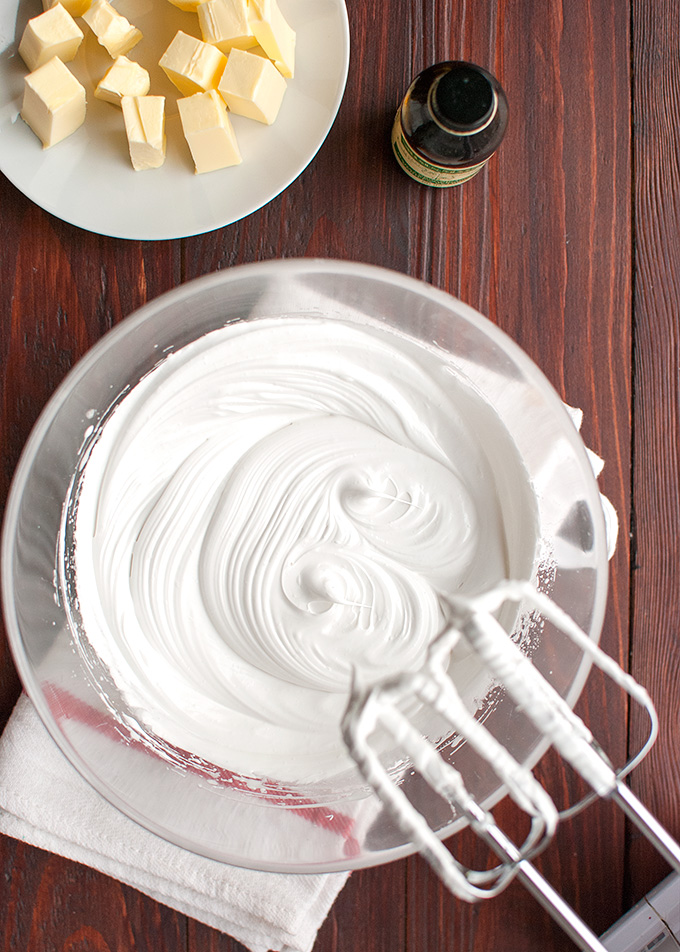 Next up, incorporating the butter. First of all, make sure the butter you use is at room temperature and nice and soft. That means 18-20°C/65-68°F. So remember to take the butter out of the fridge anywhere between 30 minutes to a few hours before you want to use it, depending on the temperature of your kitchen. Oh, and don’t try heating the butter in the microwave. You don’t want melted butter. That would just ruin your buttercream.
Next up, incorporating the butter. First of all, make sure the butter you use is at room temperature and nice and soft. That means 18-20°C/65-68°F. So remember to take the butter out of the fridge anywhere between 30 minutes to a few hours before you want to use it, depending on the temperature of your kitchen. Oh, and don’t try heating the butter in the microwave. You don’t want melted butter. That would just ruin your buttercream.
Oh, and use unsalted butter for this buttercream. For some of my other buttercreams recipes, such as the one for American buttercream, you can use the same amount of salted butter instead of the called for unsalted butter, as these recipes call for an extra pinch of salt anyway. However, this buttercream just tastes better without any salt. So, no salted butter and no extra sprinkle of salt.
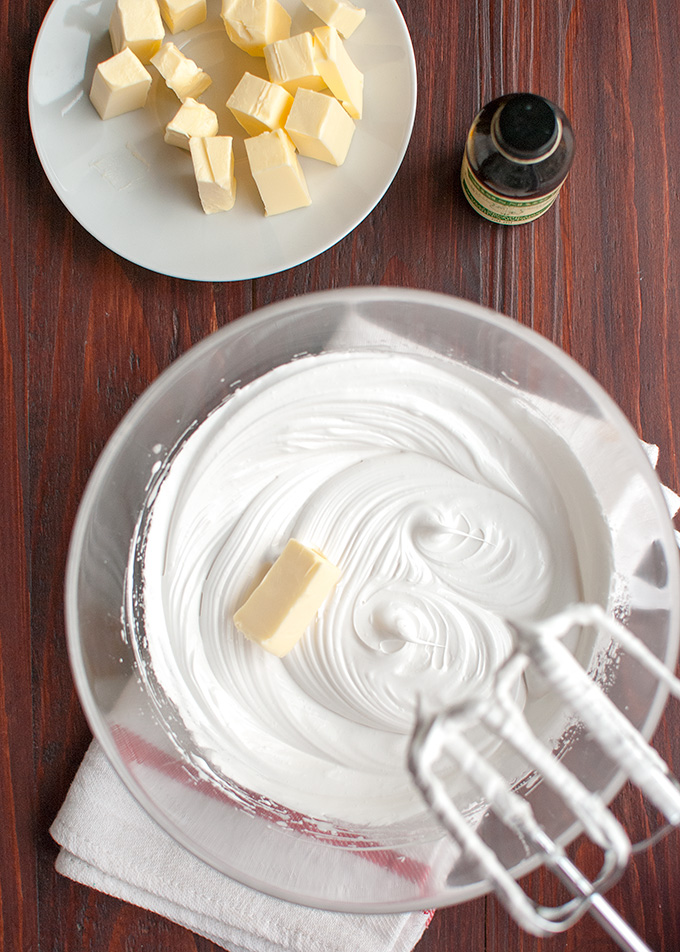 When it comes to actually combining the butter and the meringue, I prefer to use the cubed butter method for this buttercream.
When it comes to actually combining the butter and the meringue, I prefer to use the cubed butter method for this buttercream.
Although the beaten butter method works best for most buttercream recipes, I think Swiss buttercream (and Italian buttercream, for that matter) comes out fluffier and lighter when you use the cubed butter method.
For the cubed butter method, you cut cold butter into little cubes which you then allow to come to room temperature so that they’re nice and soft. You then mix the soft cubes of butter into the meringue one by one, until the buttercream comes together. Super easy…
Oh, and if the buttercream looks like it may be separating, don’t panic! Just keep mixing and eventually the buttercream will come together.
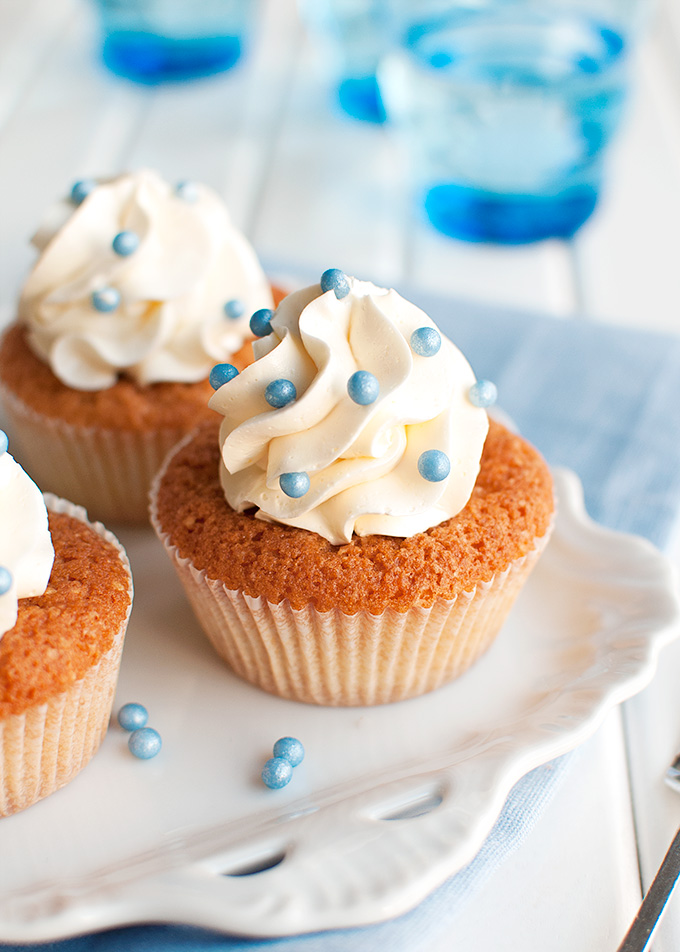 This recipe makes about 285g (about 1½ cups) of buttercream, which should be enough to generously frost 6-8 cupcakes, but the recipe can easily be doubled or tripled if you’re baking for a party.
This recipe makes about 285g (about 1½ cups) of buttercream, which should be enough to generously frost 6-8 cupcakes, but the recipe can easily be doubled or tripled if you’re baking for a party.
So what are the main characteristics of Swiss buttercream?
Color: pale ivory, and lighter than most buttercreams. It actually looks white against a dark chocolate cake.
Texture: smooth, creamy and velvety. It’s a bit denser than most other buttercreams, like flour buttercream and American buttercream.
Piping: pipes beautifully.
Level of difficulty: medium. Just as easy as making flour or German buttercream.
Fat content*: 30%
Sugar content*: 40.2%
Does it form a crust: no
* based on nutritional information.
And again I feel I need to just say something about how this buttercream compares to other buttercreams in the health department. In my previous buttercream post, about Italian buttercream, I explained that Italian buttercream is ‘healthier’ than most other buttercreams because it has less calories and contains less sugar. As my recipes for Italian and Swiss buttercream call for the same ingredients, in the same amounts, this buttercream is just as ‘healthy’!
Oh, and as opposed to Italian buttercream, you can make Swiss buttercream salmonella-safe, so I guess Swiss buttercream is the healthiest option when it comes to the six different kinds of buttercream. Nice to know, right?
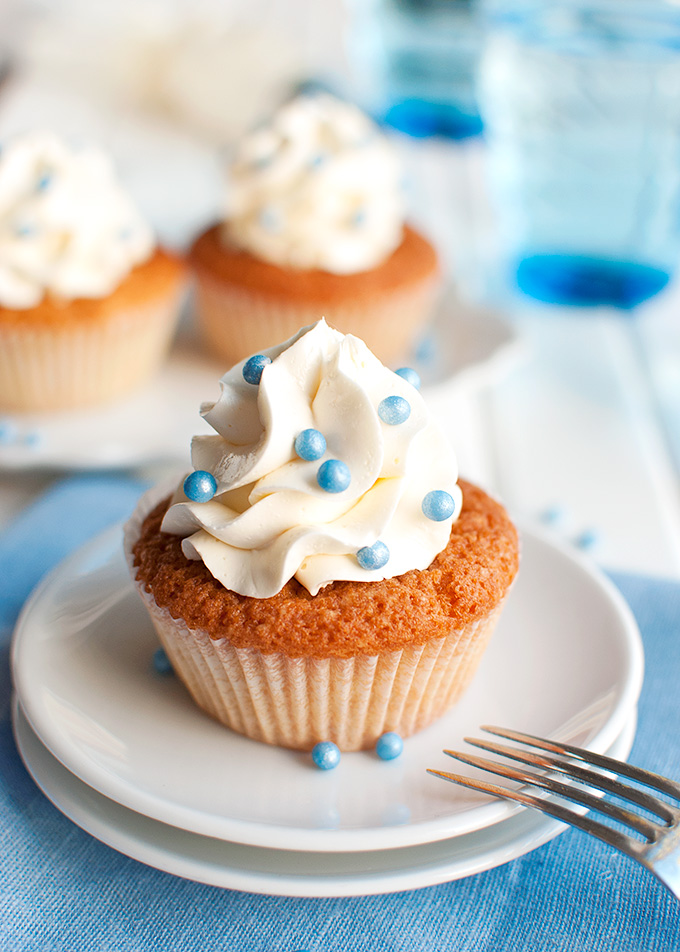 But the ultimate question: how does Swiss buttercream compare to the other buttercreams, flavor-wise?
But the ultimate question: how does Swiss buttercream compare to the other buttercreams, flavor-wise?
Well, Swiss buttercream pretty much tastes the same as Italian buttercream: not as sweet as American buttercream and not as heavy as French buttercream (which has a richer taste because it’s made with egg yolks). It also isn’t as buttery as German buttercream. All in all, it has a pleasantly light taste, which makes it the perfect buttercream to pair with fruity flavors. A bit like flour buttercream, but without the flour, which means it’s gluten-free.
Texture-wise, Swiss buttercream is also very similar to Italian buttercream. It’s a bit denser and creamier than American and flour buttercream, and a bit firmer than French and German buttercream, which makes it perfect for piping intricate designs and little details. And, like Italian buttercream, Swiss buttercream holds up pretty well in warmer temperatures. Although you should still keep frosted cakes and cupcakes out of the sun 😉
All in all, a delicious, versatile buttercream!
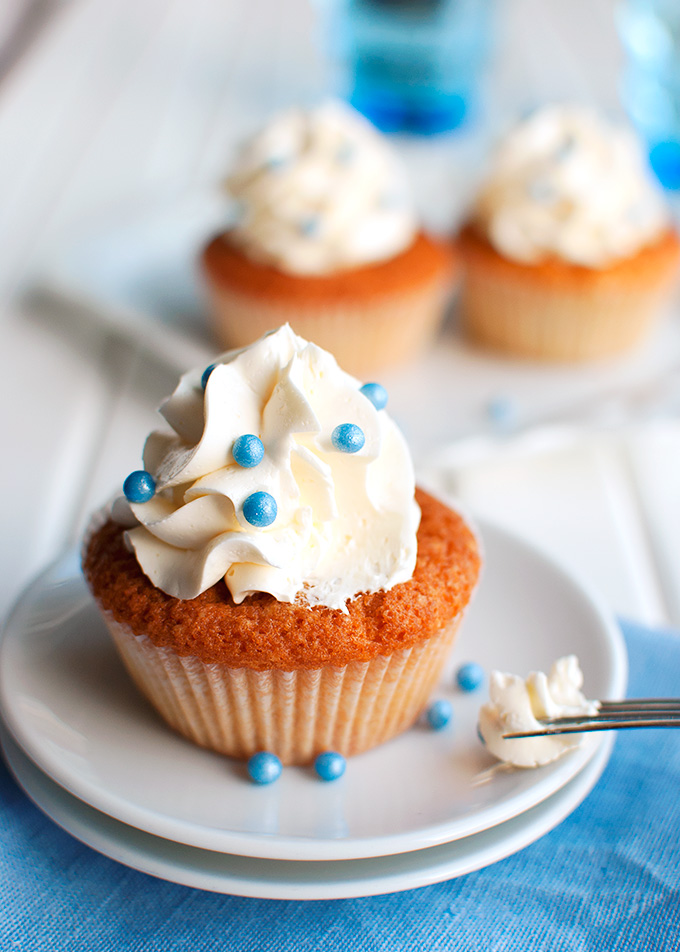 Enjoy this recipe guys! If you want to reread one of the posts in this series, just click on one of the links below:
Enjoy this recipe guys! If you want to reread one of the posts in this series, just click on one of the links below:
- How to Make American Buttercream
- How to Make Flour Buttercream (or Ermine Buttercream)
- How to Make French Buttercream
- How to Make German Buttercream
- How to Make Italian Buttercream
And just so you know: I now have Instagram! Click here to check out my brand new profile and follow me if you want to see what I post on the blog. Don’t have Instagram? Not to worry! I also have a new Mailing List. One that actually works (the previous one didn’t). So if you like me to send you an email whenever I post a delicious recipe like this find the Mailing List Form in the sidebar or click on this link to sign up.
- 2 large egg whites (about 65g or ¼ cup)
- 120g (or ½ cup + 5 teaspoons) granulated sugar
- 113g (or ½ cup) unsalted butter, cubed and softened at room temperature
- ¼ teaspoon vanilla extract
- Combine egg whites and sugar in a medium-sized heatproof bowl (or the bowl of a double boiler) and whisk until incorporated. Set the bowl over a pan of simmering water, making sure the water doesn’t touch the bottom of the bowl, and gently heat the egg mixture, whisking continuously, until the sugar has dissolved. You can check whether the sugar has dissolved by rubbing a bit of the mixture between your fingers; you should no longer feel any sugar crystals. At this point, you can either pasteurize the mixture, or use the mixture as it is.
- If you want to pasteurize the egg white mixture, continue to heat the mixture, whisking continuously, until it reaches a temperature of 71°C/160°F. You will need a sugar or candy thermometer or a multimeter to properly register the temperature. If you decide not to pasteurize the egg whites, proceed with the next step.
- Remove the egg white mixture from the heat and, using an electric whisk fitted with the whisk attachment, beat the mixture until the resulting meringue holds stiff peaks and has cooled to room temperature. The bottom of the bowl should also have cooled to room temperature.
- Once the meringue and bowl both feel cool to the touch, there are two ways of turning it into buttercream. You can use the beaten butter method or the cubed butter method.
- Add the cubed, softened butter one cube at a time, mixing well after each addition. If the mixture looks like it it’s separating after you’ve added all the butter, don’t panic. Just keep beating the mixture and the buttercream will magically come together again. If the buttercream is too soft to pipe, the butter was too hot when you added it. In that case, place the bowl with the soft buttercream in the fridge for about 20 minutes, then mix again. The buttercream should firm up.
- When the buttercream looks smooth and creamy, beat in the strained cassis or blackcurrant jam and mix until well combined. Use the buttercream immediately (or within a few hours) or store in an airtight container in the fridge for up to 2 weeks. Allow buttercream that has been refrigerated to come to room temperature, then beat with the mixer until smooth and spreadable again before using it. Frosted cupcakes can be stored in an airtight container in the fridge for up to 3 days.
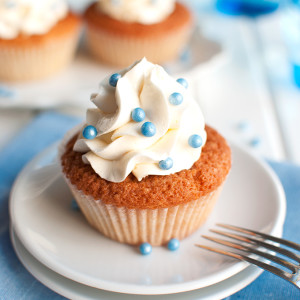
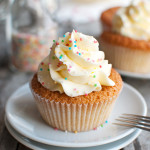
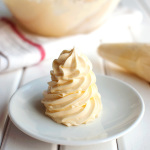
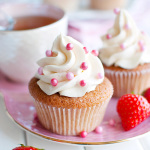
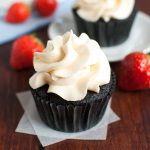


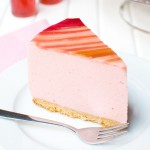
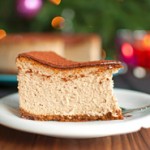
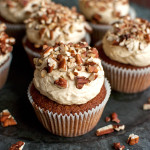
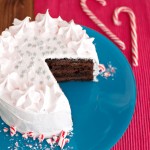
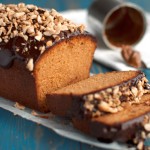
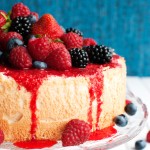

Yikes!! You’re the buttercream whisperer. I just spent the past hour going through your buttercream tutorials. I have learned so much. I wish I read this before I made Italian Buttercream for filling my macarons. It separated and I threw it out, thinking I had screwed up. Never realized I had to keep the faith and just keep beating.
I love the idea of adding a few drops of lemon to an American buttercream I am going to give it a try this week.
Great series of posts. Thanks
Thank you so much for sharing about your efforts with buttercreams! I think I’ve read most of your posts on it. I’ve made many of them, too. I like the taste of German Buttercream best, but I wonder – do you know which of these buttercreams would be best for icing a cake with? And which would NOT be good?
Hi Meredith, all of these buttercreams are delicious on cakes! So if the German buttercream is your favorite, I’d say use that one 😉
Thanks for the wonderful information on the different butter creams! I just tried to make this and my egg whites never whipped up. Why do you think that might have happened? I did halve the recipe so maybe a single egg white can’t be beaten properly? I beat it forever and ever with a regular hand mixer, but no fluff. Still tastes nice but looks more like a glaze, not light and fluffy at all.
Well, I tried it again this morning, this time making the full recipe, but I had the same result. The whites just never whipped up and the result was a frosting that is too soft to pipe. It’s pourable. Maybe my mixer is not strong enough? But I have successfully beaten raw egg whites with it in the past, so I just don’t understand why it’s not working. Any ideas? P.S. I’ve been doing the pasteurization method- does the high temperature ruin the whites for whipping?
Hi Vicky, in my experience pasteurizing the whites doesn’t ruin them for whipping. But I know other readers have had the same problem, so I don’t think it has anything to do with your mixer, especially since you’ve used it to whip up egg whites in the past. I’m still trying to figure this one out, to be honest 🙁
But here are a few things you can try… Did you try whipping the whites in a plastic bowl? Because I’ve heard plastic bowls can retain fat even after washing. Try whipping the whites in a glass or metal bowl. Another trick is to clean the beaters and bowl, then wiping them with half a lemon. The acid in the lemon gets rid of any fatty residue and helps the meringue to stiffen. Also, you might want to try different eggs (maybe a different brand, switch to organic or free-range). Another thing that might help, is to use a few more tablespoons of sugar.
Lastly, to make Swiss meringue buttercream, the meringue doesn’t necessarily have to be whipped to stiff peaks. Just use the soft glaze-like meringue and mix in cubes of softened butter. You should still end up with a fluffy meringue, because when you’re mixing in the butter, you also beat air into the mixture. Hope this helps! Please let me know how it turned out 😉
Thank you, Nila. I will try some of those suggestions. I am using a metal bowl but I did wonder if there was any fat residue in it or on the beaters. I’ll try the lemon trick and a different batch of eggs. Also, I may not have beaten long enough after adding the butter since I thought all the lift came from the whites alone. Have you ever used Cream of Tartar to help a meringue frosting? I’ll let you know how it goes!
Are you using real eggs or the eggs from a carton? If you are using eggs from a carton, there is your problem. Also- in my experience of making SMBC, I had to beat for about 20 minutes. Also, you want to make sure that your egg/sugar mixture cools as close to room temp… try to measure its temp if you can…. should be around 68-70 degrees. Also- make sure your butter is close to the exact same temp. These things should help rectify your issues. Also, you can try to add cream of tartar.. add about 1/2tsp. or 1/8tsp of Xanthan Gum.
Thanks for sharing Jami 😉
I am sorry, its driving me crazy when you say that in the Italian buttercream the eggs do not cook (become pasteurized). They do in fact cook when you pour the 240 degree F mixture into them. If you would do more research, you would know this. p.s. not saying that you haven’t done research. But the egg whites are in fact cooked in Italian BC.
Hi Jami, I know there are a lot of pastry cooks who indeed claim that pouring the sugar syrup into the egg whites pasteurizes the whites, but there are also a lot who claim that it doesn’t. So, for those readers who cannot consume raw eggs for health reasons, I decided to tread on the safe side 🙂
Hi, I have been making the Italian meringue buttercream with ur latest recipe and it came out amazing every time except the last time…. It just didn’t get thick enough… Despite refrigerating… And when I added Color…I could c the fat content seperate… The only diff was I defrosted the butter in the microwave… Please help as I had to throw two batches and I absolutely love this recipe
Hi Mariam, defrosting or bringing butter to room temperature in the microwave is always tricky. It really is best to allow it to gently soften at room temperature. If the butter is too soft, it won’t hold its shape as buttercream, because you can’t incorporate air into melted butter. I think if you allow the butter to come to room temperature by taking it out of the fridge an hour or so before you make the buttercream, you should be fine. If the buttercream splits again, keep beating the mixture until it comes together. Hope this helps 😉
It def was the microwave error… It comes out beautiful now… Thank u so much… Today I am experimenting adding cream cheese to the Swiss meringue buttercream … Would love to know if u have tried it… Also white chocolate meringue buttercream… Have u tried that…
Hi Marian, I’m so glad you figured it out! I haven’t tried adding cream cheese or white chocolate to the Swiss buttercream. I’ve been meaning to come up with a killer cream cheese buttercream recipe for a while now, though, so I’d love to hear how yours turned out! 😉
I absolutely love all of your buttercream recipes! I was wondering, do they hold up when frozen? I’m planning on making an ice cream cake for a friend’s birthday and I would really love to use this swiss buttercream to frost it, however I don’t know if it’ll thaw well after being in the freezer.
Hi Sophia, very good question! I’ms o sorry for the late response. I’ve been so busy with things and spending so much time outside!
Anyway, this buttercream certainly can be frozen in a ziplock bag, but I’ve never actually used it on an ice cream cake. However, I’ve read online that it’s totally doable. The article mentions that meringue based frostings don’t freeze as well as buttercreams, so I’m not sure what to advise you. After all, this is a meringue based buttercream. If I were you, I’d just make a small test-cake well before the party. That way you’ll know for sure 😉
i just made this and its peeerrrrrfect! after wasting a lot of time on American buttercream which i didnt like at all i found out about swiss meringue (ya i am new at baking)! and ermine as well. finally made your recipe and its sooo nice light yummy!! i will try ermine next time! keep up the good work 🙂
p.s: i just have one question i have air bubbles while piping.. how to eliminate that…?
Hi Ananya, I’m so glad you like the recipe! To get rid of the air bubbles before piping, just vigorously beat the buttercream with a rubber spatula for about a minute. That should break up most of the bubbles 😉
I am planning to either make a chocolate tort or some brownies and I will be using Crème de Menthe as flavoring. I plan on using the buttercream between the layers and maybe on top as well, if making a tort or possibly just adding a thick layer on top of some brownies. Melted chocolate would be drizzled over buttercream to finish. Which type of buttercream would work best for doing this?
Hi Kat, sorry for this late response. I’ve been sooo busy! To answer your questions, though: all of the buttercreams can be mixed with liquids, as long as you don’t use too much. A few teaspoons at least should be fine for the different recipes you can find on the site. But, since you’re going for peppermint flavor, I’d use either ermine, swiss, or Italian buttercream. These buttercreams are not made with egg yolks, making them less rich in flavor, and perfect to pair with a clean flavor such as peppermint. Have you already made the torte? How did it turn out???? 🙂